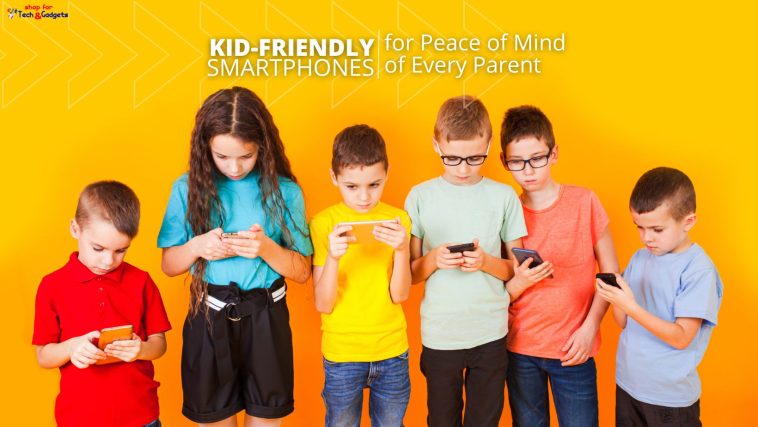In today’s digital landscape, ensuring our children have safe and appropriate access to technology is more crucial than ever. As parents, we strive to find devices that balance functionality with safety, allowing our kids to explore and learn without unnecessary risks. The right kid-friendly smartphone can provide this balance, offering robust parental controls, durability, and features tailored to young users.
Selecting the perfect device involves careful consideration of your child’s age, maturity, and your family’s specific needs. To assist you in this important decision, we’ve compiled a list of the top 10 kid-friendly smartphones in 2025 that promise to give you peace of mind while keeping your children connected and engaged.
10 Best Kid-Friendly Smartphones for Peace of Mind
1. Apple iPhone 16
The Apple iPhone 16 continues Apple’s tradition of combining cutting-edge technology with user-friendly features. It offers comprehensive parental controls through the Screen Time feature, allowing parents to monitor app usage, set time limits, and restrict content. The device also supports Family Sharing, enabling location tracking and shared purchases.
Pros:
- Access to a vast ecosystem of educational apps.
- Regular software updates ensure enhanced security.
- High-quality camera suitable for creative projects.
Cons:
- Premium price point may not be budget-friendly.
- Fragile design necessitates a protective case.
2. Google Pixel 8a
The Google Pixel 8a offers a clean Android experience with robust parental controls via the Family Link app. Parents can manage app installations, monitor screen time, and set device bedtimes. The phone’s adaptive battery ensures extended usage, and its camera quality is exceptional for its class.
Pros:
- Seamless integration with Google services.
- Regular security updates.
- Affordable pricing for the features offered.
Cons:
- Limited availability of expandable storage.
- Lacks a headphone jack, requiring wireless headphones or adapters.
3. Bark Phone
Designed with child safety in mind, the Bark Phone is a modified Samsung device equipped with comprehensive parental control software. It allows monitoring of text messages, social media activity, and screen time. The phone also provides real-time alerts for potential issues, helping parents stay informed about their child’s digital interactions.
Pros:
- Easy setup with extensive monitoring features.
- Durable build suitable for younger users.
- No contract required, offering flexibility.
Cons:
- Monthly subscription plans can be costly.
- Some alerts may experience delays.
4. Samsung Galaxy A15 5G
The Samsung Galaxy A15 5G combines affordability with performance. It features a vibrant display, long battery life, and a reliable 5G modem. Parents can utilize Samsung’s built-in parental controls to manage app access and monitor usage.
Pros:
- Budget-friendly without compromising on features.
- Expandable storage via microSD slot.
- Promises four major Android OS updates, ensuring longevity.
Cons:
- Plastic build lacks premium feel.
- No official water resistance rating.
5. Samsung Galaxy A25 5G
The Samsung Galaxy A25 5G offers a balance between performance and price. It boasts a vibrant OLED display, good camera quality, and long battery life. Parental controls are accessible through Samsung’s settings, allowing for content filtering and usage monitoring.
Pros:
- Affordable with impressive display quality.
- Good performance for everyday tasks.
- Long battery life supports extended use.
Cons:
- Lacks mmWave 5G support.
- No wireless charging capability.’
The Pinwheel Phone is designed specifically for children, featuring an operating system that blocks web browsing and social media. It allows access to over 1,200 approved apps and provides parents with tools to monitor messages, call history, and app usage remotely.
Pros:
- Emphasis on safety with restricted app access.
- Transparent monitoring fosters trust between parents and children.
- Regular updates expand the list of approved apps.
Cons:
- Monthly subscription adds to overall cost.
- Limited device models available.
7. HMD Skyline
The HMD Skyline mobile phone offers a unique “Digital Detox Mode,” allowing parents to block social media apps for specific periods. It features a durable design, a 50MP selfie camera, and a 48-hour battery life, making it suitable for active kids.
Pros:
- Encourages healthy digital habits with customizable restrictions.
- User-replaceable parts enhance longevity.
- Affordable pricing with essential smartphone features.
Cons:
- Limited app ecosystem compared to mainstream smartphones.
- May lack some advanced features found in higher-end devices.
8. Gabb Phone 4 Pro
The Gabb Phone 4 Pro prioritizes safety by limiting apps and excluding internet access. It includes GPS tracking and robust parental controls, making it ideal for younger teens or children requiring strict boundaries.
Pros:
- No internet access reduces exposure to inappropriate content.
- GPS functionality aids in location tracking.
Cons:
- Limited app selection may not appeal to older kids.
- Monthly subscription required for additional parental control features.
9. Nokia C210
The Nokia C210 is a budget-friendly option that provides a reliable and simple smartphone experience. It features a sturdy design, a large display, and access to Google Family Link for parental controls.
Pros:
- Affordable and durable, perfect for younger kids.
- Google Family Link allows parents to set screen time limits and monitor usage.
- Long battery life for extended use.
Cons:
- Slower performance compared to premium models.
- Limited storage may require frequent cleanups.
10. Jitterbug Smart4
While originally designed for seniors, the Jitterbug Smart4 is an excellent kid-friendly smartphone due to its simple interface and emergency features. Parents can set up call restrictions and limit app access, making it a great first smartphone for young users.
Pros:
- Large, easy-to-use interface.
- Emergency alert button provides additional safety.
- No unnecessary features or distractions.
Cons:
- Limited app support compared to mainstream smartphones.
- No advanced parental controls.
The Risks of Smartphones Without Parental Controls
Allowing children to use smartphones without parental supervision can expose them to various risks. Without restrictions, kids may unknowingly stumble into unsafe digital spaces, putting their safety, mental health, and financial security at risk. Here are some of the biggest concerns:
1. Unrestricted Internet Access
The internet is a vast place, and not all content is appropriate for children. Without filters or parental controls, kids can easily access violent, adult, or misleading information. Search engines and social media platforms may suggest inappropriate content based on browsing history, making it difficult for young users to avoid harmful material. Additionally, misinformation on the internet can mislead children, shaping their beliefs in ways that may not be accurate or healthy.
2. Excessive Screen Time
Too much screen time can negatively impact children’s well-being in multiple ways. Studies have shown that excessive smartphone use can disrupt sleep patterns, leading to fatigue and decreased focus in school. Additionally, prolonged screen time reduces physical activity, which can contribute to obesity and other health issues. Without time limits, children may also struggle with digital addiction, prioritizing their screens over real-world interactions with family and friends.
3. Online Safety Risks
Children may unknowingly interact with online predators, scammers, or cyberbullies through social media and messaging apps. Many online platforms encourage anonymous interactions, making it easier for predators to disguise themselves as friendly peers. Cyberbullying is another major concern—kids can become victims of harassment, leading to emotional distress, anxiety, and depression. Without parental monitoring, children may not recognize red flags or know how to handle dangerous online situations.
4. Uncontrolled Spending
Many apps and games include in-app purchases that allow users to buy digital goods with real money. Without proper restrictions, kids can make unintended purchases, racking up large bills before parents even realize it. Some mobile games use manipulative tactics, such as limited-time offers and virtual currencies, to encourage spending. Additionally, children might fall for scams that trick them into entering payment details or subscribing to unwanted services.
5. Privacy Concerns
Children often don’t fully understand online privacy and may share personal information without realizing the risks. They might disclose their name, location, school, or other identifying details on social media, making them vulnerable to identity theft, stalking, or online tracking. Some websites and apps collect user data for advertising purposes, which could expose children to targeted ads and marketing strategies designed to influence their behavior.
By allowing children to use smartphones without parental control, parents expose them to a range of potential dangers. Fortunately, most modern kid-friendly smartphones include built-in safety features to help parents manage these risks. Taking an active role in guiding children’s smartphone usage can help ensure a safe and healthy digital experience.
Final Thoughts: Choosing the Right Kid-Friendly Smartphone
Finding the best kid-friendly smartphone depends on your child’s needs and your level of comfort with their digital independence. Devices like the iPhone 16 and Google Pixel 8a offer strong parental controls, while options like the Gabb Phone 4 Pro and Pinwheel Phone eliminate internet risks altogether.
As technology continues to evolve, staying involved in your child’s digital life is essential. The right smartphone, combined with open communication and clear guidelines, can ensure a safe and positive experience for your child.




